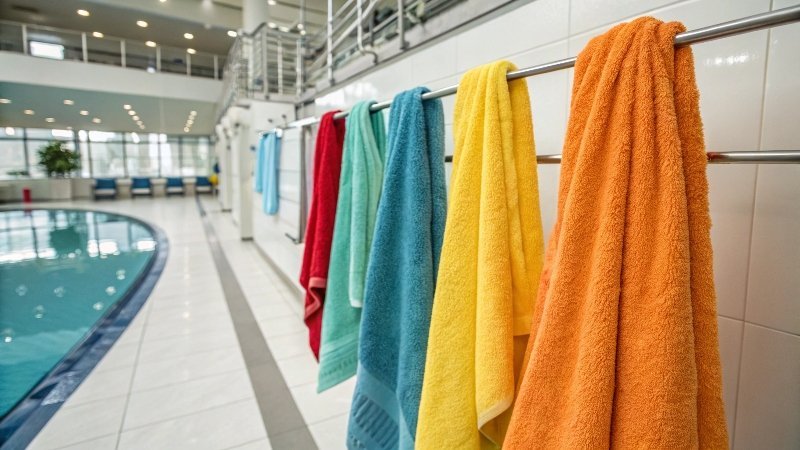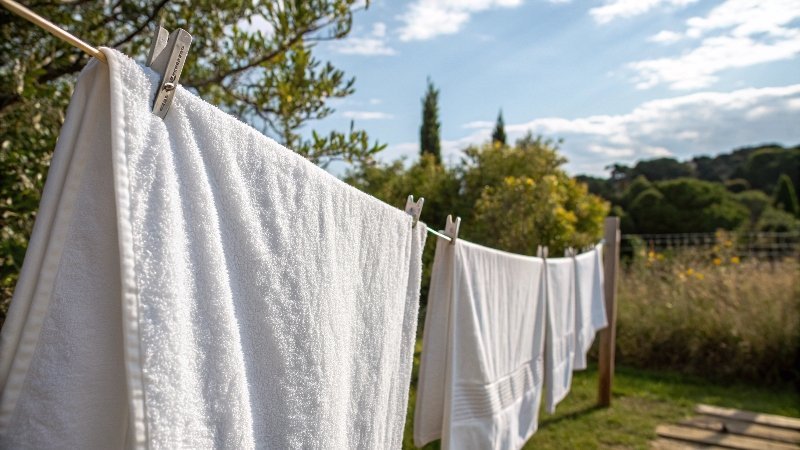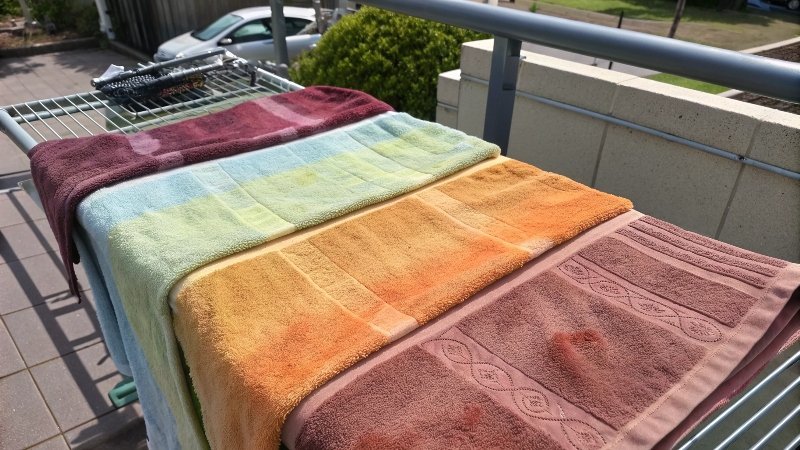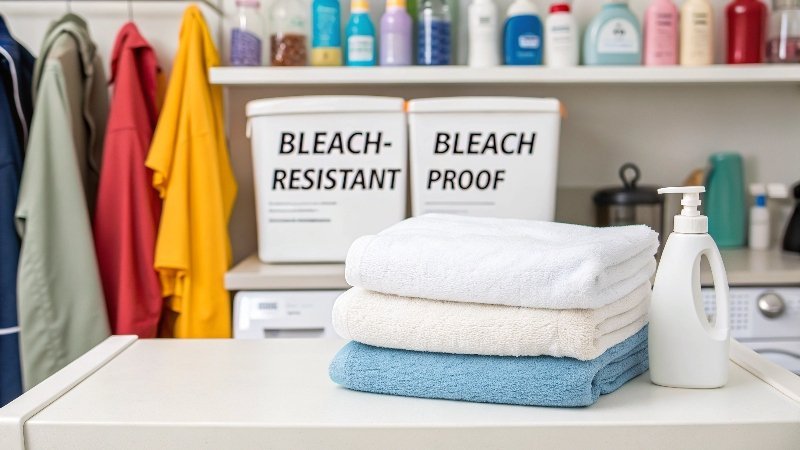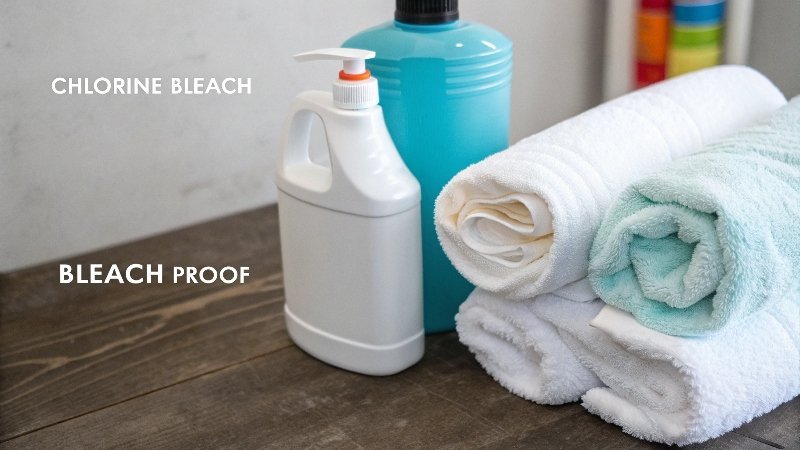Do you worry about bleach ruining your towels? Unsightly stains can be costly and damage your brand’s reputation. Let’s explore bleach-proof towels to protect your investment.
Bleach-proof towels are specially dyed to resist fading and discoloration from bleach and other harsh chemicals. They are crucial for salons, spas, hotels, and gyms where strong cleaning agents are common. Their colorfastness ensures they look new for longer, protecting your investment.
I’ve seen countless clients, from high-end salons to boutique hotels, struggle with this exact problem. They invest in beautiful, colored towels only to see them ruined after a few washes. It’s frustrating and expensive. But there is a solution, and it’s simpler than you might think. Let’s break down exactly how these towels work and if they are the right choice for your business.
Are there bleach resistant towels?
Tired of replacing towels because of bleach spots? It’s a constant, expensive cycle. Yes, truly bleach-resistant towels do exist, and they are a game-changer for many businesses.
Yes, bleach-resistant towels are a real and widely available product. They are made using a special dyeing process with vat dyes, which chemically bond with the cotton fibers. This makes them impervious to the color-stripping effects of bleach and other oxidizing agents.
The magic behind these towels isn’t magic at all; it’s advanced textile chemistry. Most standard colored towels use reactive dyes. These dyes form a strong bond with the cotton, but it’s a bond that oxidizing agents like bleach can break. This is what strips the color away, leaving those ugly orange or white spots. Bleach-resistant towels, on the other hand, use something called vat dyes. I remember a salon chain client who was spending a fortune replacing their chic, charcoal grey towels every quarter. The culprit was not just laundry bleach, but also hair coloring products and peroxide-based cleaners. We switched them to a vat-dyed towel from our collection. The initial cost per towel was slightly higher, but their replacement orders dropped by over 90% in the first year. The return on investment was immediate and obvious. The difference is all about how the dye integrates with the fabric.
Vat Dyes vs. Reactive Dyes
Vat dyes are a class of dyes that are insoluble in water in their original state. We use a chemical process to make them soluble, apply them to the cotton, and then oxidize them back into the fiber. This process essentially traps the dye pigment inside the cotton fiber itself. Because the color is locked in, bleach simply can’t get to it to break it down. Reactive dyes, in contrast, form a covalent bond on the surface of the fiber, which is strong but still vulnerable.
| Feature | Vat Dyed (Bleach Resistant) | Reactive Dyed (Standard) |
|---|---|---|
| Bleach Resistance | Excellent | Poor |
| Colorfastness | Superior, less fading from sun/wash | Good, but vulnerable to bleach |
| Process | Complex, multi-step chemical process | Simpler, more common dyeing method |
| Cost | Slightly higher initial cost | Lower initial cost |
| Best For | Salons, gyms, hotels, healthcare | Home use, general purpose gifting |
This technology is what ensures your towels maintain their deep, uniform color and professional appearance, wash after wash.
How do bleach proof towels work?
The term "bleach-proof" can sound like a marketing gimmick. This uncertainty might make you stick with standard towels, even if it’s costly. The science is actually very straightforward.
Bleach-proof towels work because they are colored with vat dyes. Unlike standard dyes that sit on the fiber’s surface, vat dyes are locked inside the cotton fibers through a chemical process. This makes the color pigment physically inaccessible to bleach’s stripping agents.
Let’s walk through the process more closely. Imagine a single cotton fiber as a tiny, hollow tube. With standard reactive dyeing, we’re essentially painting the outside of that tube. It looks great initially, but a harsh chemical like bleach can easily scrub that paint off. Vat dyeing is a much more clever process. We take the pigment, which starts as a solid, and use a chemical reaction to make it water-soluble. This allows the tiny dye particles to penetrate deep inside the cotton fiber’s tube.
The Vat Dyeing Process
- Reduction: First, we use a reducing agent to change the insoluble dye pigment into a soluble "leuco" state. The towels are then soaked in this solution.
- Absorption: In its soluble form, the dye can penetrate deep into the core of each cotton fiber. It doesn’t just sit on the surface; it fills the fiber.
- Oxidation: Next, we expose the towel to air or a chemical oxidizing agent. This triggers a reverse reaction. The dye becomes insoluble again, growing into larger pigment particles that are now trapped permanently inside the fiber. It’s now physically part of the towel’s internal structure.
Because this process is so robust, you can pour bleach right on the towel without any color loss. This is why these towels are sometimes called "indanthrene dyed," referring to a specific class of high-performance vat dyes. The trade-off is that the process is more complex and limits the color palette slightly. You won’t find as many neon brights, but the core colors needed for professional environments—like black, charcoal, navy, burgundy, and hunter green—are incredibly stable and readily available. The return on investment is clear: you buy towels that last.
How to avoid bleach stains on towels?
One wrong splash can ruin a brand-new, expensive towel. This constant vigilance is exhausting for your staff and often fails. The easiest way to avoid bleach stains is to use towels designed to resist them.
The most effective way to avoid bleach stains is to purchase towels specifically labeled as bleach-proof or bleach-resistant. For standard towels, you must enforce strict laundry protocols: separate colors, avoid bleach-containing acne products, and use color-safe, non-chlorine bleach alternatives.
While choosing bleach-proof towels is the ultimate solution, proper care protocols can help extend the life of any towel. I often consult with hotel procurement teams who are managing massive inventories across multiple properties. One of their biggest points of failure isn’t always the main laundry process; it’s accidental cross-contamination on housekeeping carts or in storage. A leaking bottle of bathroom cleaner containing bleach that drips onto a stack of fresh towels can cause thousands of dollars in damage in an instant. That’s why operational protocols are just as important as the product you choose.
Strategies for Stain Prevention
For businesses committed to using standard colored towels, prevention is everything.
- Segregation: Keep towels completely separate from cleaning rags that may have been used with bleach-based products. I advise clients to use color-coded bins and carts to make this foolproof for staff.
- Product Awareness: Be mindful of hidden bleach sources. Many common acne treatments contain benzoyl peroxide, which acts just like bleach on fabrics. This is a huge, often overlooked, issue for spas and hotels.
- Laundry Discipline: Train staff meticulously to read chemical labels and use only non-chlorine, color-safe bleach for any colored loads.
Here’s a simple comparison of the two approaches:
| Strategy | For Standard Towels | For Bleach-Proof Towels |
|---|---|---|
| Primary Method | Strict avoidance & careful handling | Use of bleach as needed for sanitation |
| Laundry | Separate washes, non-chlorine bleach only | Can be washed with other whites and chlorine bleach |
| Main Risk | Accidental contact with bleach or peroxides | Minimal to no risk of color damage |
| Effort Level | High operational discipline required | Low; forgiving of human error |
Ultimately, for a busy commercial environment like a salon or gym, relying on perfect human behavior 24/7 is a risky and expensive bet. Investing in bleach-proof towels removes that risk variable from the equation.
Is bleach safe on towels?
You need your towels to be hygienically clean, especially in a commercial setting. But you’ve likely heard that bleach destroys fabric over time. Let’s clarify when it’s safe to use and when it’s destructive.
Chlorine bleach is safe for white cotton towels and colored bleach-proof towels, as it sanitizes without stripping color. However, it is not safe for standard colored towels, as it will cause irreversible discoloration. Overuse on any towel can weaken cotton fibers over time.
This is a critical question for anyone in the hospitality, wellness, or health industries. The answer really has two parts: safety for the towel’s color and safety for the towel’s fabric. We’ve already established that chlorine bleach is only safe for the color of pure white towels or specially vat-dyed towels. But what about the cotton fibers themselves? Chlorine bleach is a powerful chemical. It works by breaking down chemical bonds, which is how it kills germs and obliterates stains. Unfortunately, it can’t perfectly distinguish between a stain molecule and a cellulose molecule (the building block of cotton fiber). Over time, repeated exposure to harsh, undiluted bleach will progressively break down that cellulose. This makes the cotton fibers weaker and more brittle, which leads to towels feeling less soft and eventually developing rips, thin spots, or holes.
Best Practices for Using Bleach
If you must use chlorine bleach for sanitation, following these rules will maximize the life of your towels:
- Use on the Right Towels: Only use it on 100% white cotton or certified bleach-proof colored towels.
- Dilute Properly: Never pour bleach directly onto dry towels. Allow the washing machine to fill with water, add your detergent and the recommended amount of bleach to the water, and then add the towels.
- Use Sparingly: Don’t use bleach in every single wash cycle. Use it strategically when deep sanitation is absolutely required, not for routine cleaning.
- Consider Alternatives: For general whitening and brightening, oxygen bleach (products with sodium percarbonate) is a much gentler alternative that is safe for most colored fabrics. It works more slowly but doesn’t degrade the cotton fibers as quickly. For my clients, we often recommend a hybrid approach: use bleach-proof towels for maximum color safety, and create a laundry plan that relies on hot water and oxygen bleach for regular washes, saving chlorine bleach only for occasional deep-sanitizing cycles. This approach gives you the perfect balance of hygiene and maximum towel lifespan.
Conclusion
Choosing bleach-proof towels is a smart investment. It protects your inventory from stains, ensures a professional look, and simplifies your laundry operations, saving you money and stress long-term.

